| Deployed War-Fighter Protection (DWFP) Program |

|
What is DWFP?
Why is DWFP needed?
Despite existing measures to prevent and control arthropod-borne diseases in military units, diseases constitute serious threats to deployed troops. Due to a shrinking list of safe, cost-effective pesticides for control of disease vectors, new and improved materials and methods for pesticide delivery are needed by the armed forces. Besides encouraging the rapid development of such products, the DWFP program aims to improve the capability of USDA to provide long term, innovative support to military preventive medicine, providing funding to ARS to reinvigorate a mutually beneficial relationship between the two DOD and USDA.
What will be done?
Research at USDA laboratories involves the discovery, evaluation, development, and optimization of: 1) new pesticides effective against mosquitoes and flies; 2) new personal protection products effective in preventing mosquito and fly bites, and 3) new application and personal protection methodologies and strategies.
Projected Studies
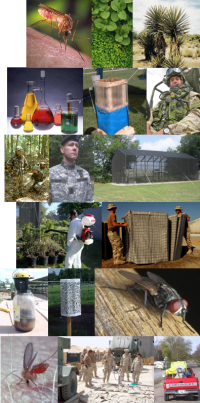
Novel insecticide chemistries or formulations
1.1. New compounds
1.2. Native plant compounds
1.3. Physiological responses to new compounds
Personal protection
2.1. Revaluation of "old" repellents
2.2. Sustained release repellents
2.3. Spatial repellent in military tents
2.4. Repellent-treated uniforms, fabrics and tent materials
2.5. Sand fly protection
2.6. Fly traps and baits
2.7. Repellents and inhibitors against infected mosquitoes
Application technology
3.1. Pesticides on natural barriers
3.2. Barrier treatments in Anopheles habitats
3.3. Barrier treatments in desert habitat
3.4. Treatment of tactical military barriers
3.5. Electrostatic and other sprayers
3.6. Thermal fog machines
3.7. Insecticide-treated visual targets for flies
3.8. Mosquito coils
3.9. Repellents, inhibitors, and barrier treatments in Sub-Saharan habitat
3.10. Repellents, inhibitors, and barrier treatments in humid tropical habitat
Insectary
 |
The two new insectary buildings being added to the CMAVE complex were funded by the DOD-sponsored Deployed War-Fighter Protection (DWFP) program. This research program will test and develop management tools for pest and vector species transmit diseases to the deployed troops. The first building will contain 3 environmental chambers for rearing insects and a greenhouse for rearing and experiments that require natural daylight. |
| Occupancy date for this first building is expected for fall 2006 when outfitting of the building will be complete. A second insectary building with eight 10’x20’ temperature-, humidity-, and light-controlled chambers is expected to be completed by late summer 2006. These two buildings will allow a great expansion of the mosquito and fly rearing, including new species and insecticide-resistant colonies needed for DWPF-related research within and outside MFRU, as well as other MFRU research. Currently MFRU rears 9 mosquito and 4 fly species, including 3 strains of house flies, and plans to add sand fly colonies soon. When all mosquito colonies are transferred to the new insectary, the old mosquito insectary will be refurbished to provide additional lab and office space for DWFP activities. |
 August, 2006  August, 2006 |
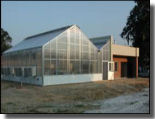 May, 2006 |
Cooperative Activities
- Federal partners
- Military Laboratories
- USDA-ARS Laboratories
- APMRU, College Station, TX
- CAIBL, Beltsville, MD
- NPURU, Oxford, MS
- Commercial partners
- Pesticide Companies
- Application Equipment Manufacturers
- Mosquito Control Companies
- University of Florida
- Mosquito control districts
- New partners for international field sites
Toxicology Research to Discover New Insectides
Screen Chemicals
Different bioassay methods are used to test various activities of candidate insecticides.

Contact bioassay

Topical application
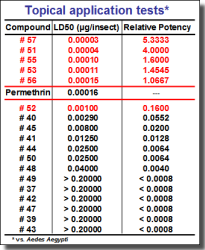
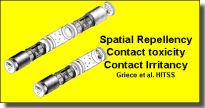 Pesticidal chemistries have been tested against adult mosquitoes in order to select new active ingredients that can be registered and used in the control of public health pests. Several products have been determined to be better than the standard treatment in laboratory tests. Filed tests with different formulations will determine which products best fit the needs of the Armed Forces.
Pesticidal chemistries have been tested against adult mosquitoes in order to select new active ingredients that can be registered and used in the control of public health pests. Several products have been determined to be better than the standard treatment in laboratory tests. Filed tests with different formulations will determine which products best fit the needs of the Armed Forces.
Determine modes of action
In order to determine the mode of action of new chemical insecticides, these compounds will be added to a suspension of ground mosquitoes which contains all possible proteins that the insecticide may target. The insecticide and the target protein will bind, allowing the isolation of this protein-insecticide complex. Once that complex is separated from the mixture, the target protein can be identified. Toxicants that target new proteins found only in the pest insects are ideal for use as insecticides because they should be very safe to humans and the environment.
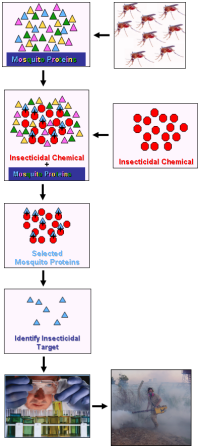
Spatial Repellents for Military Tents in Deployment Situations
In collaboration with the Navy DVECC, Military tents were placed individually into two large outdoor screened cages. A Mosquito Magnet Pro (MMP) was operated inside the tents to simulate a human host and to attract and capture mosquitoes. A sticky paper sheet was used to capture flies. Repellent devices are being tested in different locations within the tents, with different door configurations. Insects are released near the north wall of each tent (50 house flies, 50 stable flies at ca. 10:00 A.M., and 300 female Aedes aegypti and Ochleratatus taeniorhynchus at ca. 4:00 P.M.) Each test runs for 24 h starting at 10:00 A.M.
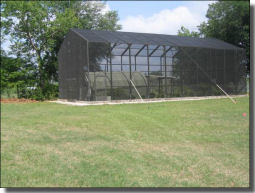 Military tents were erected inside enclosures where mosquitoes and flies were released |
 Insect attractants simulated the presence of military personnel in the tent |
Biological Validation for Effectiveness of Impregnated Military Uniforms
A protocol for a bite-protection assay for mosquitoes has been developed and approved for testing military uniforms. The MFRU at CMAVE wrote the specifications and protocols and conducts the biological validation of military uniforms. Permethrin-impregnated U.S. Marine Corps Combat Utility Uniforms (MCCUUs) were examined for their ability to retain a biologically efficacious level of treatment both soon after production and after multiple launderings. Companies that wish to supply the treated uniforms must meet the biological protection specifications designated in the approved protocol.
 Without Permethrin |
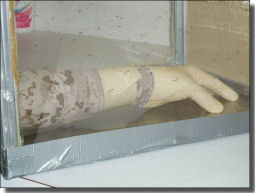 Permethrin-treated |
Spatial Repellent Delivery Field Kits
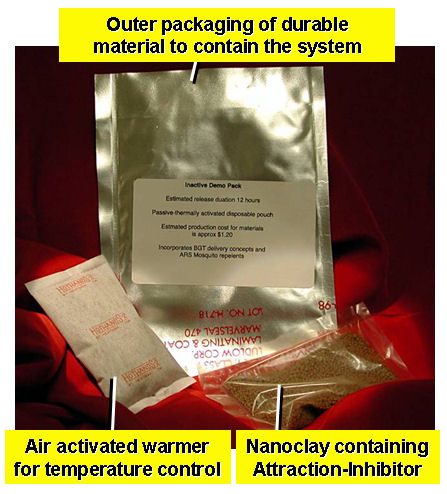
In collaboration with a commercial partner, CMAVE researchers are developing and testing sustained-release delivery systems for masking agents. These products are designed to prevent mosquitoes and flies from biting military personnel in the field.
